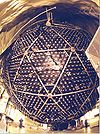- Neutrino Ettore Majorana Observatory
-
Not to be confused with the Neutrino Mediterranean Observatory, which is also abbreviated NEMO.For other uses, see Nemo (disambiguation).
The Neutrino Ettore Majorana Observatory (NEMO experiment) is an international collaboration of scientists searching for neutrinoless double beta decay. The observation of neutrinoless double beta decay would be evidence that neutrinos are Majorana particles and could be used to measure the neutrino mass. It is located in the Modane Underground Laboratory (LSM) in the Fréjus Road Tunnel. Data taking started in January 2003 and ended in January 2011.
Contents
Experiment
The experiment has a cylindrical shape with 20 sectors that contain different isotopes in the form of thin foils with a total surface of about 20 m2. The main isotopes used for the neutrinoless double beta decay search are about 7 kg of enriched molybdenum-100 and about 1 kg of selenium-82. The experiment also contains smaller amounts of cadmium-116, neodymium-150, zirconium-96 and calcium-48 foils. Tellurium and copper foils are used for background measurements.
A tracking detector on each side of the foil detects electrons and positrons from the double beta decay. Electrons and positrons are identified through their curvature in a magnetic field. The energy of the electrons and positron is then measured in a calorimeter. In neutrinoless double beta decay, the sum of the electron and positron energies will be the same as the energy (Q value) released in the double beta decay process. For the standard double beta decay process the two neutrinos, which cannot be observed directly, will take some of the energy thereby reducing the energy sum for the electron and positron.
No neutrinoless double beta decays have been observed during about 5 years of data taking. In 2009, the NEMO-3 experiment therefore reported that the half life for neutrinoless double beta decay of molybdenum-100 is greater than 1024 years. This can be translated into an upper limit on the neutrino mass of about 0.5–1.0 eV, depending on the nuclear model used to calculate the neutrino mass from the half-life.
SuperNEMO
A next generation experiment, SuperNEMO, is currently under construction. It is based on technology used by the NEMO-3 experiment, but will be more than a factor of ten bigger.[1] The SuperNEMO detector will consist of 20 modules each containing approximately 5 kg of enriched double beta decay emitting isotope in the form of a thin foil. Isotopes under consideration for SuperNEMO are selenium-82, neodymium-150 and calcium-48. The installation of a first module in the LSM is expected in 2012.
References
- ^ R. Arnold et al. (2010). "Probing new physics models of neutrinoless double beta decay with SuperNEMO". European Physical Journal C 70: 927–943. Bibcode 2010EPJC...70..927A. doi:10.1140/epjc/s10052-010-1481-5.
External links
Neutrino detectors, experiments, and facilities Discoveries 
Operating Construction Retired Proposed Cancelled See also Categories:- Neutrino observatories
Wikimedia Foundation. 2010.
